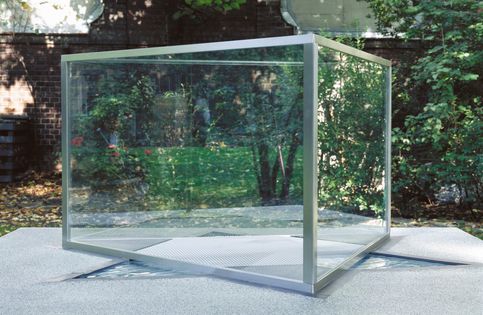Model for Star of David Pavilion

Dan Graham
Model for Star of David Pavilion, 1989
Architecture model Two-way mirror, aluminum, acrylic glass, wooden floor, varnished in blue and strewn with quartz sand, steel stand, varnished in gray 42.4 x 101.4 x 101.4 cm Edition 1/3
GF0000190.00.0-1995
Artwork text
This pavilion, consisting of two superimposed equilateral triangular forms, one a basin of water, the other a 2.5 m high, enclosed two-way mirror glass pavilion will be positioned to the side and below the bridge leading to the castle’s entrance. Originally this area was a moat; now it will be landscaped into a grassy, tree-shaded area ideal for picnics or quiet, restful leisure activity. The choice of water as an active element makes a relation to a nearby, surrounding river, which leads to an ecologically efficient electro-power dam designed by students of the Schloss Buchberg’s curator. It is intended for access and possible use by year-long residents of the local village as well as temporary use by visitors. Each triangular form is four meters on each side. The enclosed pavilion is entered through sliding doors. Each of the exterior triangular water basins are 1.33 m as are the other stone-based outer triangular points. Ist interior area is filled with water (continuing the water of the triangular basin). The spectator can walk over the water on an overlying steel grid similar to the urban grids on sidewalks. From the ground level, three 1.33 m equilateral triangular water ponds are adjacent to the grass. The reflective-glassed pavilion can be entered through a sliding door on one of its triangular points where the spectator first steps onto a stone floor. The entire pavilion can be seen from above looking through the overgrown ivy on the top of the wall at the side of the bridge traversing over the “moat-area” into the castle’s entrance. From this vantage both water and two-way mirror becomes a complex of crystalline multi-reflective surfaces in relation to the people in the pavilion and beside the “Star of David” form. The Jewish “Star of David” iconography of the configuration is very clearly apparent. (Dan Graham)